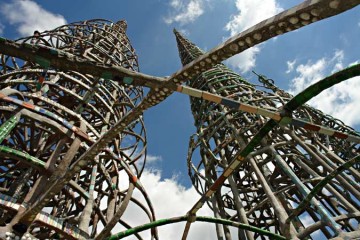
The Watts Towers, view of 99-foot tower, which contains the longest slender reinforced concrete column in the world. Courtesy www.wattstowers.us
Fifty years after public outcry stopped the city of Los Angeles from demolishing the world-famous Watts Towers, Angelenos once again rallied to rescue the complex from the City Council chopping block. While the network of 17 interconnected spiraling structures–built from salvaged materials over the course of 33 years by immigrant Simon Rodea-–was not in physical peril this time, the Los Angeles City Council aimed to raze funding for two city-owned art centers that are part of the Watts Towers complex. Council members had proposed closing or privatizing many of the municipal community art centers, including the Watts Towers Arts Center, which provides tours of the now nationally recognized folk art monument, as well as free workshops, lectures, exhibitions, concerts, and community outreach. In 1970, the local community founded and developed the facility through a grassroots fund raising effort known as the “One Square Inch” campaign $1.00 for each square inch of the building. Five years later, the community deeded the site to the city of Los Angeles, and the Municipal Arts Department began operating the WTAC. Given the community’s historic involvement in preserving the site and developing the center, it is no surprise that the proposal to shut down public support for the complex was met with opposition.
Los Angeles has worked long and hard to establish itself as a cutting-edge art capital, but the city’s mammoth financial woes may cause it to falter from its path toward becoming a leading center for artistic and cultural innovation. In the face of shouldering the burden of Los Angeles’s budget deficit–which could be anywhere between 500 million and 1 billion dollars in the next fiscal year–the Department of Cultural Affairs has begun the process of cutting its expenditures in half by laying off workers and seeking private enterprises to operate many of the city’s public arts centers. Los Angeles owns a unique network of twenty-five community arts centers around the city, and has previously cut spending by partnering with private nonprofits at ten of these sites. The city council proposed cutting funding entirely to nine more of these centers, hoping to find more private enterprises to operate them. However, finding nonprofits capable of running these centers could prove to be difficult, if not impossible. If the city is unable to find private partners, the centers on the list may shut down entirely.
The directors, educators, and staff at the Watts Towers Art Center and adjacent Charles Mingus Youth Arts Center, as well as the William Grant Still Arts Center and the Warner Grand Theatre, already received pink slips last month. The facilities faced the prospect of shuttering starting this week, until the City Council voted on Friday to explore the possibility of funneling away from public art projects for the next two years, essentially granting a stay of execution for its network of community art centers. The money would come from the Public Arts Redevelopment Tax Fund, which earmarks 1% of all new city-funded construction projects for new public art works. Council members emphasize that this reallocation of public art dollars is by no means a permanent solution, and the city continues to seek private enterprises to take over many of the city cultural facilities.
Watts Towers, built entirely from salvaged steel rods, pipes, mortar, broken ceramic tile, and found glass. Courtesty www.wattstowers.us
The two art centers surrounding the Watts towers, however, have been removed entirely from the privatization list, thanks to the protest staged last Wednesday, letters from the community, and a petition that pledges to “stop cultural genocide” by asking Mayor Antonio Villaraigosa and the City Council to keep the Watts Towers complex in the hands of the public.
All of this news comes in the wake of a major identity crisis for Los Angeles. We’ve got Eli Broad establishing a multimillion dollar foothold at the Los Angeles County Museum of Art, a New York commercial dealer taking the reigns of our city’s central Contemporary Art Museum, and threats from private landowners to bulldoze the HOLLYWOOD sign. It may not be much, you know, but that sign is our version of the Empire State Building. Public space has never been Los Angeles’s strong suit, so we need all we can get. But the more our deficit balloons outward, the more our public arenas shrink.
A sign reading "Save the Peak" was draped over the Hollywood Sign as part of a campaign to stop demolition planned by investors who wish to sell the land to developers. Photo by Bauer Griffin. Courtesy www.popbytes.com.